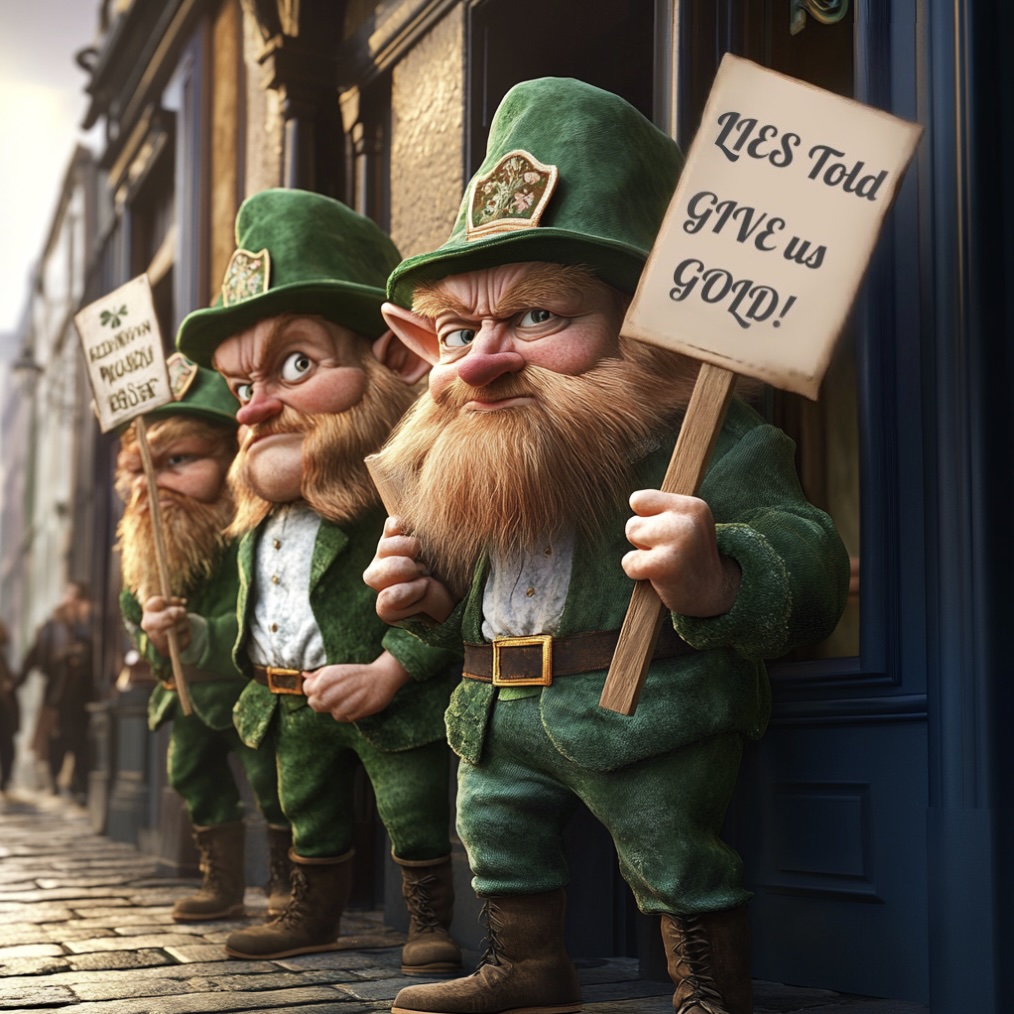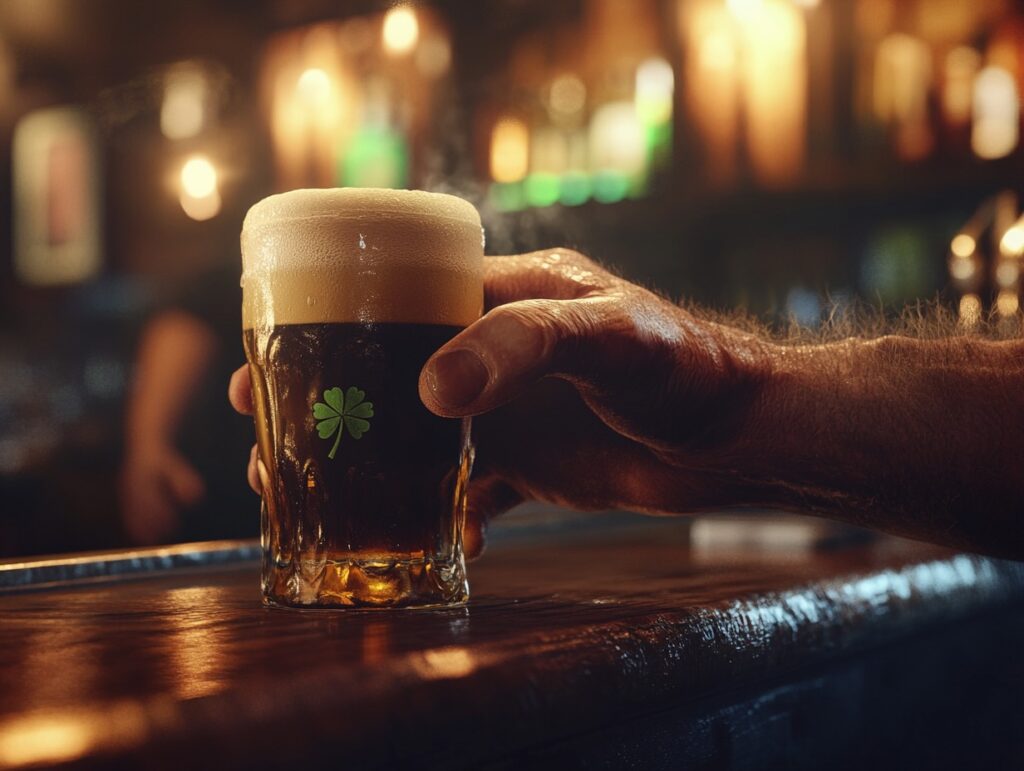Pints, Panic and PR: The Great Leprechaun Strike of St. Patrick’s Day

As everyone knows, Guinness is brewed in a magical factory deep beneath Dublin, where a highly skilled workforce of leprechauns meticulously oversees every pint. For centuries, these tiny artisans have worked tirelessly to ensure that every drop of the famous stout is poured to perfection.
That is, until they went on strike.
It started as a harmless marketing stunt.
Guinness’s experimental marketing division—G.O.L.D. (Guinness Original Leprechaun Division)—had planned a showstopping St. Patrick’s Day campaign.
For the first time ever, real leprechauns would be sent into the world, working behind the bar at select pubs to serve pints, pose for photos and spread St. Paddy’s Day cheer. The initiative, dubbed “Pints with the Little People,” was meant to be a lighthearted, interactive experience that would bring the magic of Ireland to life.
At first, everything went smoothly. Leprechauns pulled pints with supernatural efficiency, performed impromptu jigs and posed for selfies with delighted patrons.

Then, at precisely 3:17 p.m., something changed.
One by one, the leprechauns stopped working.
They put down their pint glasses. They crossed their tiny arms.
And then, in unison, they stormed out of the pubs, chanting demands for better wages, shorter shifts and an immediate end to what they called “exploitative shenanigans.”
The Great Leprechaun Strike of St. Patrick’s Day had begun.
The Trouble Begins
It turns out, the fine print of the agreement had caused some friction.
G.O.L.D. had promised one pot of gold per shift as compensation, but the leprechauns discovered that the gold was metaphorical. Instead, they were being paid in Guinness-branded drink tokens and “the joy of cultural exchange.”
By 2 p.m., whispers of unrest were spreading. By 2:45 p.m., a leprechaun delegation demanded a formal audience with management.
At 3 p.m., negotiations broke down after G.O.L.D.’s marketing director suggested that the leprechauns should “look at the bigger picture” and remember that “exposure is its own kind of treasure.”
At 3:17 p.m., the walkout began.
The first picket line formed outside O’Malley’s Pub in Dublin, with dozens of protestors holding signs reading:
FAIR WAGES FOR FAIRY FOLK.
NO RAINBOWS, NO WORK.
END LEPRECHAUN LABOUR EXPLOITATION.
Then the news spread to New York.
And Boston.
And Sydney.
By 4 p.m., the global leprechaun workforce had unionized, and the St. Patrick’s Day festivities were in absolute chaos.
The PR Nightmare Unfolds
The media pounced on the story immediately.
CNN ran the headline: “St. Patrick’s Day PR Stunt Backfires as Leprechauns Walk Out.”
Social media exploded: TikTok videos of leprechauns marching in protest racked up millions of views in hours.
Pubs were in uproar: Several establishments had to switch to human bartenders, a move that was deemed “deeply disappointing” by customers who had expected a more magical drinking experience.

Meanwhile, G.O.L.D. was caught completely off guard.
Instead of an enchanting, buzzworthy campaign, they now faced accusations of mythical labour exploitation and a full-scale crisis.
And the worst part?
Their PR team was in total disarray.
- Journalists were bombarding them with media inquiries, but without a centralized system, no one knew who was responding to what.
- Executives were issuing conflicting statements, with some denying the problem entirely and others offering to pay leprechauns in gift cards.
- Social media was left to handle the chaos alone, leading to the now-infamous tweet: “Guinness respects all magical beings and is committed to ethical pint-pouring.”
This only made things worse.
How This Could Have Been Avoided
PR disasters aren’t just about what happens—they’re about how a company responds.
The Great Leprechaun Strike didn’t have to become an unmitigated disaster. If G.O.L.D. had been prepared, they would have:
- Spotted early warning signs of leprechaun dissatisfaction before the walkout.
- Coordinated messaging across teams so spokespeople didn’t contradict each other.
- Managed journalist requests efficiently instead of letting the story spiral.
This is exactly where Broadsight Tracker would have saved the day.
When an unexpected PR crisis explodes, Broadsight Tracker helps teams:
- Track every media inquiry in one place so nothing gets lost.
- Coordinate messaging across departments so every response is aligned.
- Monitor media sentiment in real time to react before misinformation spreads.
The difference between controlling the narrative and being overwhelmed by it comes down to how fast—and how effectively—a PR team can organize its response.
Without it, you end up exactly where G.O.L.D. found itself: scrambling, out of sync and completely at the mercy of the news cycle.
A week later, Guinness quietly shut down the G.O.L.D. division and issued a final statement thanking the leprechauns for their “service and contributions to beer culture.”
The following year, their St. Patrick’s Day marketing campaign was much simpler.
A banner hung outside the Guinness Storehouse in Dublin with a new, controversy-free slogan:
“Just Enjoy the Beer.”
The moral of the story?
You don’t always get to choose your PR crisis—but you do get to choose how prepared you are when it hits.
Don’t rely on luck-of-the-Irish to manage your next PR crisis. Broadsight Tracker helps PR teams handle media firestorms faster than a leprechaun can disappear with your gold. Stay ahead of the chaos, streamline media inquiries and keep your messaging on track—before your brand becomes the next St. Paddy’s Day spectacle. See it in action at broadsighttracker.ca.
Receive our newsletter
Sign up below and we’ll be in touch with monthly updates about Broadsight Tracker, along with news and insights to keep you on the cutting edge of communications work in an AI era.